Let's query the GitHub GraphQL API from a Livebook smart cell
- Author: Stephen Ball
- Published:
-
- Permalink: /blog/lets-query-the-github-graphql-api-from-a-livebook-smart-cell
In which we write a Livebook smart cell to allow querying the Github GraphQL API
Continuing from last time when we wrote an absolutely minimal livebook smart cell we’re going to write a Livebook smart cell that allows us to easily query the GitHub GraphQL API.
Previously
Last time we wrote the simplest of simple smart cells. It only printed out a couple of hardcoded strings and completely ignored the frontend user experience.
This time out we’ll write an interactive smart cell. Our goal will be to let a user paste in a GitHub API token, a GraphQL query, and name a variable that will receive the query results. The smart cell will execute the GraphQL query and store the results in the given variable name.
Querying the GitHub GraphQL API
If you just want to skip to querying the GitHub GraphQL API via Livebook then
you can simply start a new livebook notebook, add the
github_graphql_smartcell package, add a “GitHub GraphQL Query” smart cell,
and you’re all set!
GitHub GraphQL Smart Cell on
But if you’d like to read through how to implement a more complex smart cell then let’s go!
Let’s write a smart smart cell!
Our actually smart fancy new smart cell will handle performing a GraphQL query against the GitHub GraphQL API.
Again our first job is to figure out the pattern of code we want our smart cell to generate.
- What (if any) dependencies does our smart cell need to function? Kino for smart cell functionality, Neuron for handling GraphQL queries, and jason to handle JSON.
- What end result do we want our cell to have? Print some output? Assign results to a variable? Interact with the Livebook users? Users should be able to fill in a GitHub API token, graphql query, and variable name to receive the results
As always, first we spike the code required.
Spiking the code
We’ll use the excellent Neuron to serve
as our GraphQL client and jason to handle JSON.
We’ll also need a GitHub personal access token as described by their documentation Forming calls with GraphQL
Livebook is a perfect prototyping environment, let’s get a Livebook going!
Either use the package adding UI to find and add neuron and jason or copy this setup code. Then run the setup to install the dependencies.
Mix.install([
{:neuron, "~> 5.0"},
{:jason, "~> 1.3"}
])
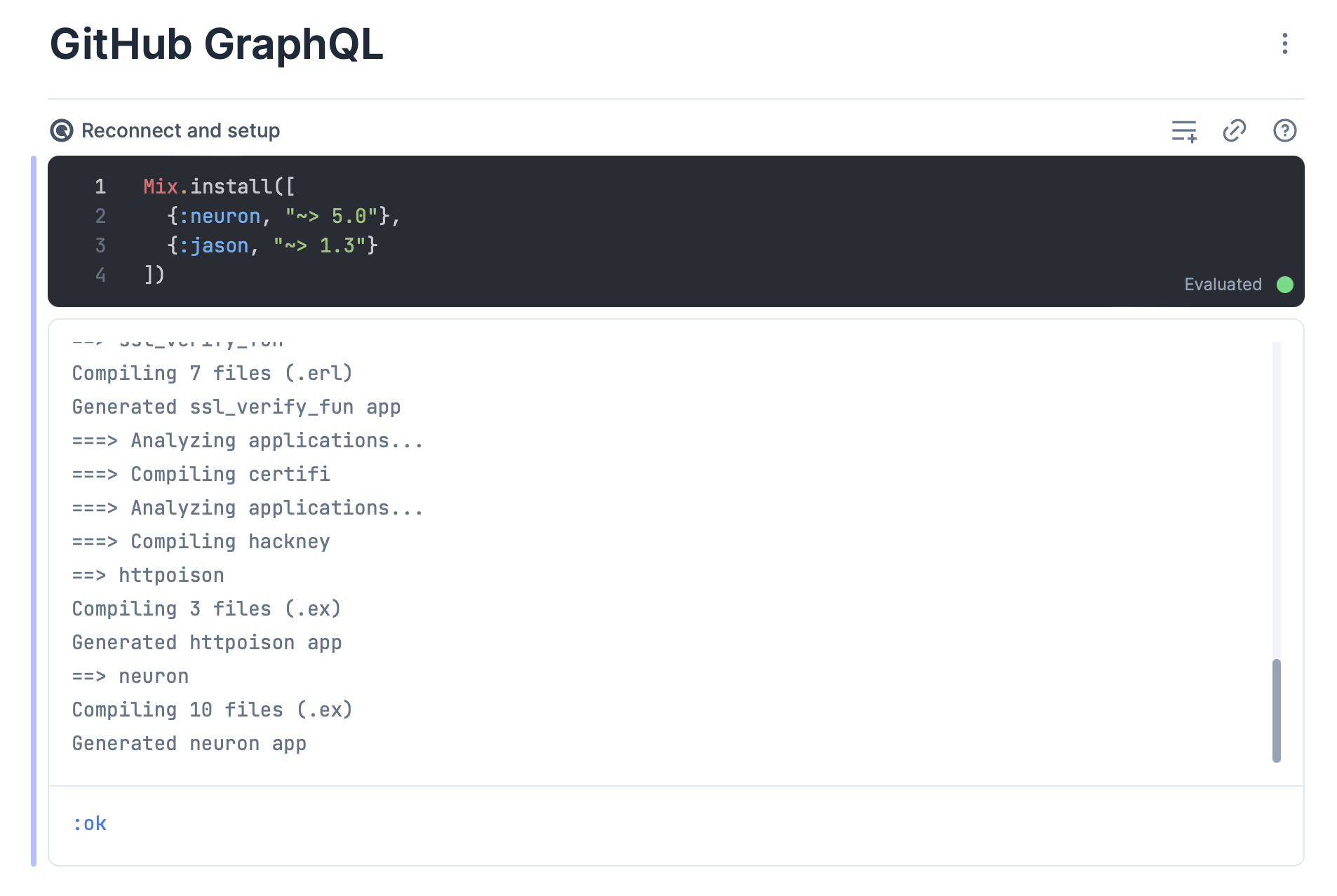
Making our first GitHub GraphQL call
Believe it or not, we’re ready to make a GitHub GraphQL API call!
Drop this code into a code block and run it.
token = "ghp_YOUR_TOKEN_HERE"
endpoint = "https://api.github.com/graphql"
Neuron.query("{ viewer { login }}", %{},
url: endpoint,
headers: [authorization: "Bearer #{token}"]
)If all goes as it should you should see results!

{:ok,
%Neuron.Response{
body: %{"data" => %{"viewer" => %{"login" => "sdball"}}},
headers: [
{"Server", "GitHub.com"},
{"Date", "Sat, 21 May 2022 19:25:31 GMT"},
{"Content-Type", "application/json; charset=utf-8"},
{"Content-Length", "38"},
{"X-OAuth-Scopes",
"read:discussion, read:gpg_key, read:org, read:packages, read:public_key, read:repo_hook, repo, user"},
{"X-Accepted-OAuth-Scopes", "repo"},
{"github-authentication-token-expiration", "2022-06-20 18:37:06 UTC"},
{"X-GitHub-Media-Type", "github.v4; format=json"},
{"X-RateLimit-Limit", "5000"},
{"X-RateLimit-Remaining", "4997"},
{"X-RateLimit-Reset", "1653161963"},
{"X-RateLimit-Used", "3"},
{"X-RateLimit-Resource", "graphql"},
{"Access-Control-Expose-Headers",
"ETag, Link, Location, Retry-After, X-GitHub-OTP, X-RateLimit-Limit, X-RateLimit-Remaining, X-RateLimit-Used, X-RateLimit-Resource, X-RateLimit-Reset, X-OAuth-Scopes, X-Accepted-OAuth-Scopes, X-Poll-Interval, X-GitHub-Media-Type, X-GitHub-SSO, X-GitHub-Request-Id, Deprecation, Sunset"},
{"Access-Control-Allow-Origin", "*"},
{"Strict-Transport-Security", "max-age=31536000; includeSubdomains; preload"},
{"X-Frame-Options", "deny"},
{"X-Content-Type-Options", "nosniff"},
{"X-XSS-Protection", "0"},
{"Referrer-Policy", "origin-when-cross-origin, strict-origin-when-cross-origin"},
{"Content-Security-Policy", "default-src 'none'"},
{"Vary", "Accept-Encoding, Accept, X-Requested-With"},
{"X-GitHub-Request-Id", "E1DB:33B8:695955:15E21B7:62893CAB"}
],
status_code: 200
}}There’s a lot there in the headers, but nothing we need. At least nothing we need yet. The key data we’re after is the response body.
%{"data" => %{"viewer" => %{"login" => "sdball"}}}Let’s get some pattern matching and some code structure going to give us nice abstraction to get at the data.
Abstracting our query interface
Start a new code cell. This will hold our module responsible for handling the GitHub GraphQL queries.
defmodule GitHub.GraphQL do
end
Our module will have a query/2 method that will accept an endpoint and a config map.
defmodule GitHub.GraphQL do
def query(query, config) do
Neuron.query(query, %{},
url: config[:endpoint],
headers: [authorization: "Bearer #{config[:token]}"]
)
end
end
We can call query/2 like so
"""
{ viewer { login }}
"""
|> GitHub.GraphQL.query(
endpoint: "https://api.github.com/graphql",
token: "ghp_************************************"
)And it works!
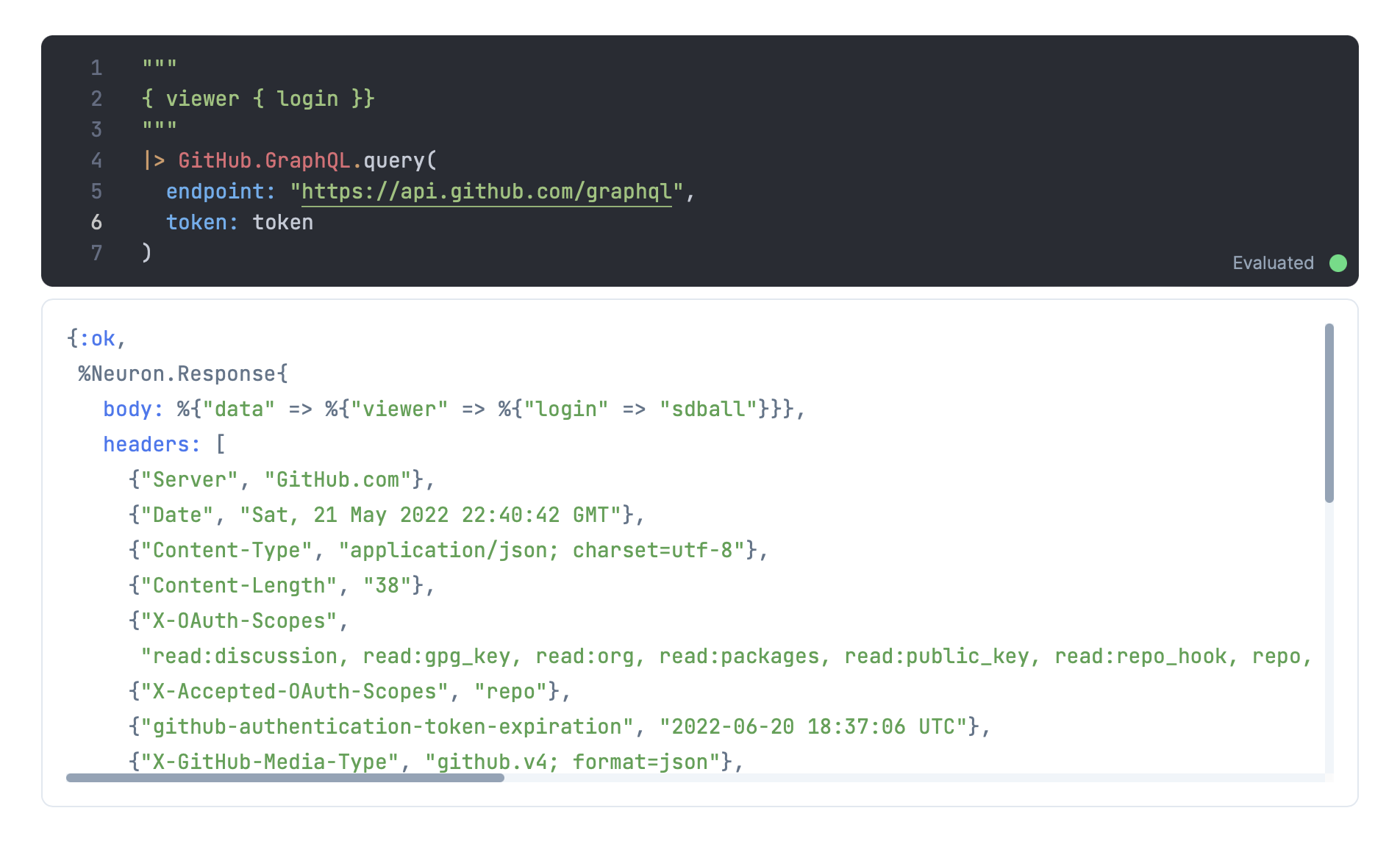
Now let’s extract out the actual data as a convenience and also recognize some error patterns.
defmodule GitHub.GraphQL do
def query(query, config) do
query
|> request(config)
|> case do
{:ok, %Neuron.Response{status_code: 200, body: %{"errors" => errors}}} ->
{:error, errors}
{:ok, %Neuron.Response{status_code: 200, body: %{"data" => data}}} ->
{:ok, data}
{:error, %Neuron.Response{body: body}} ->
{:error, body}
error ->
error
end
end
def request(query, config) do
Neuron.query(query, %{},
url: config[:endpoint],
headers: [authorization: "Bearer #{config[:token]}"]
)
end
endThere, now we can display the body if the response is good, or the key context of various errors we recognize, or whatever error response doesn’t match anything else.


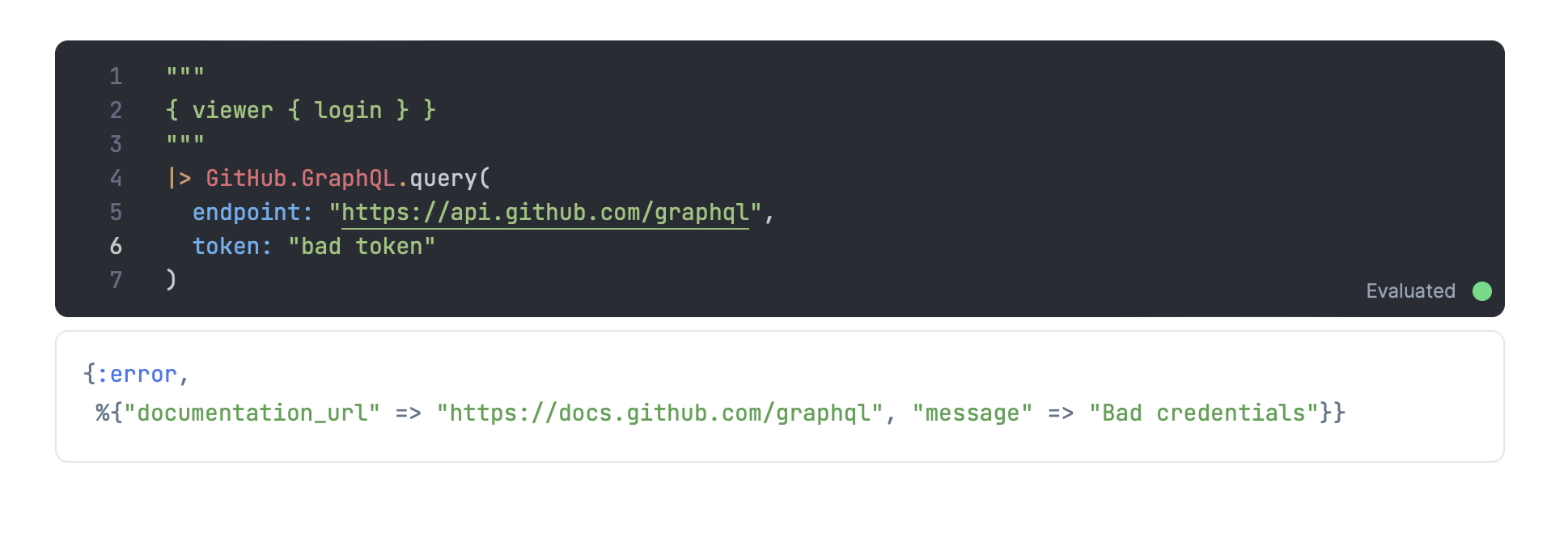
We can even submit more complex queries and they work just fine.
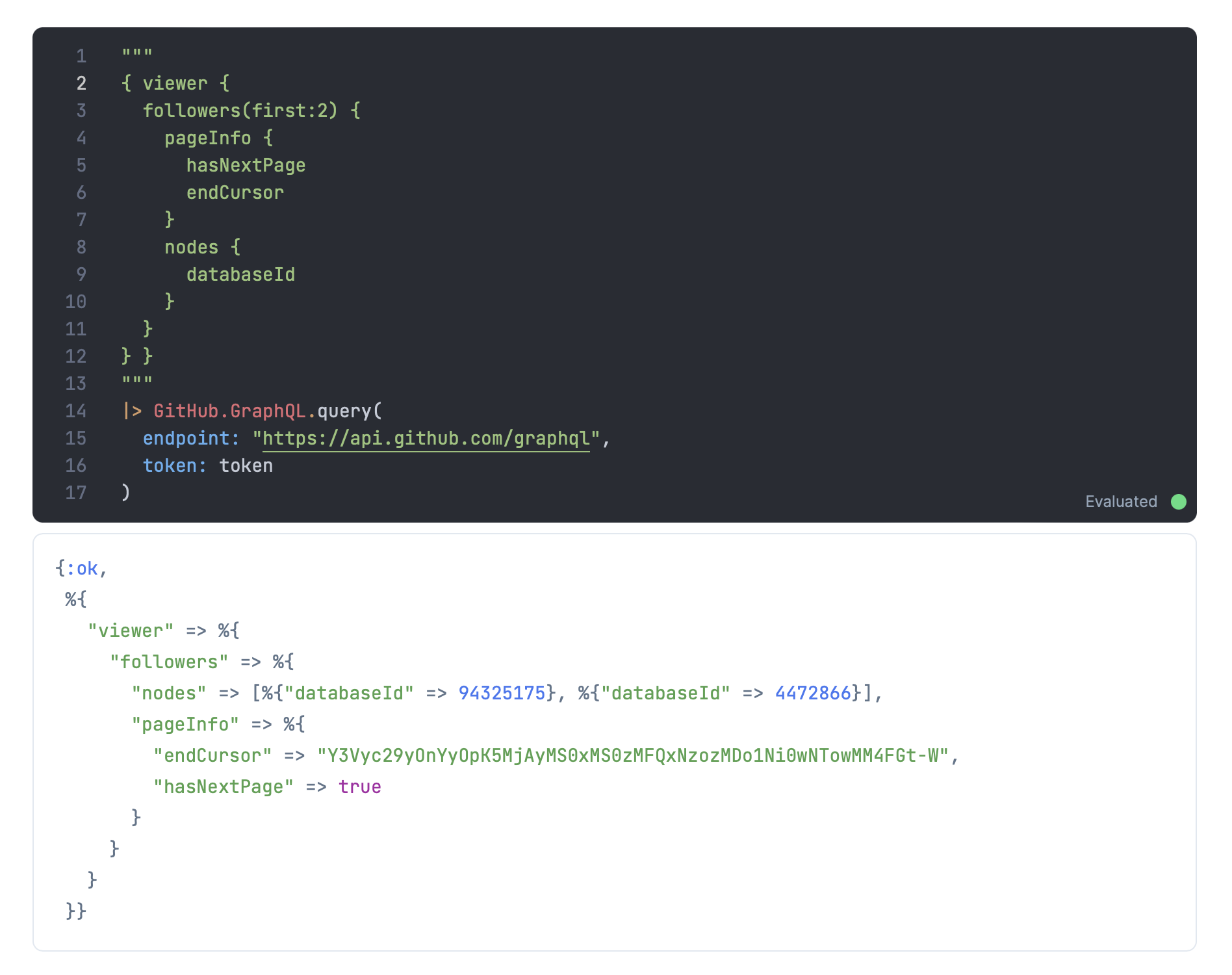
Hey check out that pageInfo in the query and response. That’s how GraphQL
does pagination which we won’t cover here. But the gist is that you have to ask
for the pagination info as part of your request and use the info in the
response to construct your next request until you either have collected all the
data you want or you’ve reached the end of the pages.
In the actual package I’ve got an initially acceptable pagination abstraction working. But I wouldn’t claim it to be complete yet.
If you want to chase those details then Stream paginated GraphQL API in Elixir is well worth a read. If you look at my github_graphql_smartcell repo you’ll see its pagination is entirely informed by that post.
For now, let’s wrap the single unpaginated query behavior we’ve got into a smart cell.
Actually writing the smart cell
Like we did for the “not ready” smart cell let’s do this right and package up our code.
$ mix new github_graphql_smartcell
$ cd github_graphql_smartcellAdd kino, jason, and neuron to our package dependencies and declare an application in mix.exs
defmodule GithubGraphqlSmartcell.MixProject do
use Mix.Project
def project do
[
app: :github_graphql_smartcell,
version: "0.1.0",
elixir: "~> 1.13",
start_permanent: Mix.env() == :prod,
deps: deps()
]
end
def application do
[
mod: {GithubGraphqlSmartcell.Application, []}
]
end
defp deps do
[
{:kino, "~> 0.6.1"},
{:neuron, "~> 5.0"},
{:jason, "~> 1.3"}
]
end
end
Write out the lib/application.ex file to register our smart cell.
defmodule GithubGraphqlSmartcell.Application do
@moduledoc false
use Application
@impl true
def start(_type, _args) do
Kino.SmartCell.register(GithubGraphqlSmartcell)
children = []
opts = [strategy: :one_for_one, name: KinoDB.Supervisor]
Supervisor.start_link(children, opts)
end
endLet’s put our GitHub.GraphQL module into our package.
$ mkdir lib/github
$ vim lib/github/graphql.exIn that file simply paste in the module we spiked above.
defmodule GitHub.GraphQL do
def query(query, config) do
query
|> request(config)
|> case do
{:ok, %Neuron.Response{status_code: 200, body: %{"errors" => errors}}} ->
{:error, errors}
{:ok, %Neuron.Response{status_code: 200, body: %{"data" => data}}} ->
{:ok, data}
{:error, %Neuron.Response{body: body}} ->
{:error, body}
error ->
error
end
end
def request(query, config) do
Neuron.query(query, %{},
url: config[:endpoint],
headers: [authorization: "Bearer #{config[:token]}"]
)
end
endNow we have all the pieces ready: time to add the smart cell!
At last, the smart cell
Unlike our previous smart cell this smart cell will have a UX component. A form that allows users to enter their GitHub endpoint, API token, and GraphQL query.
That means we’ll need a real main.js file and we may as well supply a real main.css file to make things look nice. The behavior is very similar to the database connector smart cell that ships with Livebook so that was the perfect place for me to steal reference files and rework them to fix our needs here.
Since we need real files for our assets, we’ll make it easy and declare an
assets_path in our smart cell.
$ mkdir -p lib/assets/github_graphql_smartcell
$ touch lib/assets/github_graphql_smartcell/main.js
$ touch lib/assets/github_graphql_smartcell/main.cssNow we’ll go through each file in turn.
main.css
Our main.css is the simplest file here so let’s start there. Like most of my smart cell pieces this is totally ripped off from the database connection smart cell that ships with Livebook.
.app {
font-family: "Inter";
box-sizing: border-box;
--gray-50: #f8fafc;
--gray-100: #f0f5f9;
--gray-200: #e1e8f0;
--gray-300: #cad5e0;
--gray-400: #91a4b7;
--gray-500: #61758a;
--gray-600: #445668;
--gray-800: #1c2a3a;
--blue-100: #ecf0ff;
}
input,
select,
textarea,
button {
font-family: inherit;
}
.container {
border: solid 1px var(--gray-300);
border-radius: 0.5rem;
background-color: rgba(248, 250, 252, 0.3);
padding-bottom: 8px;
}
.row {
display: flex;
align-items: center;
padding: 8px 16px;
gap: 8px;
}
.header {
display: flex;
justify-content: flex-start;
background-color: var(--blue-100);
padding: 8px 16px;
margin-bottom: 12px;
border-radius: 0.5rem 0.5rem 0 0;
border-bottom: solid 1px var(--gray-200);
gap: 16px;
}
.input {
padding: 8px 12px;
background-color: var(--gray-50);
font-size: 0.875rem;
border: 1px solid var(--gray-200);
border-radius: 0.5rem;
color: var(--gray-600);
}
input[type="number"] {
appearance: textfield;
}
.input::placeholder {
color: var(--gray-400);
}
.input:focus {
outline: none;
border: 1px solid var(--gray-300);
}
.input--sm {
width: auto;
min-width: 300px;
}
.input--xs {
width: auto;
min-width: 150px;
}
.input--text {
max-width: 50%;
}
.input-label {
display: block;
margin-bottom: 2px;
font-size: 0.875rem;
color: var(--gray-800);
font-weight: 500;
}
.inline-input-label {
display: block;
margin-bottom: 2px;
color: var(--gray-600);
font-weight: 500;
padding-right: 6px;
font-size: 0.875rem;
text-transform: uppercase;
}
.field {
display: flex;
flex-direction: column;
}
.inline-field {
display: flex;
flex-direction: row;
align-items: baseline;
}
.grow {
flex-grow: 1;
}
.info-box {
margin-bottom: 24px;
padding: 16px;
border-radius: 0.5rem;
white-space: pre-wrap;
font-weight: 500;
font-size: 0.875rem;
background-color: var(--gray-100);
color: var(--gray-500);
}
.info-box p {
margin: 0;
padding: 1em 0 0.3em;
}
.info-box p:first-child {
padding-top: 0;
}
.info-box span {
color: var(--gray-600);
padding-left: 0.5em;
}
.hidden {
display: none;
}
@media only screen and (max-width: 750px) {
.mixed-row .field {
max-width: 32%;
}
.input--number {
max-width: 100%;
}
}
input::-webkit-outer-spin-button,
input::-webkit-inner-spin-button {
-webkit-appearance: none;
margin: 0;
}main.js
The main.js file is actually real this time! It holds the form for input and handles getting the user data back to the smart cell to turn into code.
The interactions of this file could be a blog post to themselves. So we’ll move on for now.
import * as Vue from "https://cdn.jsdelivr.net/npm/vue@3.2.26/dist/vue.esm-browser.prod.js";
export function init(ctx, info) {
ctx.importCSS("main.css");
ctx.importCSS(
"https://fonts.googleapis.com/css2?family=Inter:wght@400;500&display=swap"
);
const app = Vue.createApp({
template: `
<div class="app">
<!-- Info Messages -->
<form @change="handleFieldChange">
<div class="container">
<div class="row header">
<BaseInput
name="variable"
label=" Assign query results to "
type="text"
placeholder="Assign to"
v-model="fields.variable"
inputClass="input input--xs input-text"
:inline
:required
/>
</div>
<div class="row">
<BaseInput
name="endpoint"
label="Endpoint"
type="text"
placeholder="https://api.github.com/graphql"
v-model="fields.endpoint"
inputClass="input"
:grow
/>
</div>
<div class="row">
<BaseInput
name="api_token"
label="API Token"
type="password"
placeholder="PASTE API TOKEN"
v-model="fields.api_token"
inputClass="input"
:grow
/>
</div>
<div class="row">
<BaseTextArea
name="query"
label="Query"
type="text"
placeholder="{ now }"
v-model="fields.query"
inputClass="input"
:grow
/>
</div>
</div>
</form>
</div>
`,
data() {
return {
fields: info.fields,
};
},
methods: {
handleFieldChange(event) {
const { name, value } = event.target;
ctx.pushEvent("update_field", { field: name, value });
},
},
components: {
BaseInput: {
props: {
label: {
type: String,
default: "",
},
inputClass: {
type: String,
default: "input",
},
modelValue: {
type: [String, Number],
default: "",
},
inline: {
type: Boolean,
default: false,
},
grow: {
type: Boolean,
default: false,
},
number: {
type: Boolean,
default: false,
},
},
template: `
<div v-bind:class="[inline ? 'inline-field' : 'field', grow ? 'grow' : '']">
<label v-bind:class="inline ? 'inline-input-label' : 'input-label'">
{{ label }}
</label>
<input
:value="modelValue"
@input="$emit('update:data', $event.target.value)"
v-bind="$attrs"
v-bind:class="[inputClass, number ? 'input-number' : '']"
>
</div>
`,
},
BaseTextArea: {
props: {
label: {
type: String,
default: "",
},
inputClass: {
type: String,
default: "input",
},
modelValue: {
type: [String, Number],
default: "",
},
inline: {
type: Boolean,
default: false,
},
grow: {
type: Boolean,
default: false,
},
number: {
type: Boolean,
default: false,
},
},
template: `
<div v-bind:class="[inline ? 'inline-field' : 'field', grow ? 'grow' : '']">
<label v-bind:class="inline ? 'inline-input-label' : 'input-label'">
{{ label }}
</label>
<textarea
rows=10
:value="modelValue"
@input="$emit('update:data', $event.target.value)"
v-bind="$attrs"
v-bind:class="[inputClass, number ? 'input-number' : '']"
>
</div>
`,
},
},
}).mount(ctx.root);
ctx.handleEvent("update", ({ fields }) => {
setValues(fields);
});
ctx.handleSync(() => {
// Synchronously invokes change listeners
document.activeElement &&
document.activeElement.dispatchEvent(
new Event("change", { bubbles: true })
);
});
function setValues(fields) {
for (const field in fields) {
app.fields[field] = fields[field];
}
}
}lib/github_graphql_smartcell.ex
And the smartcell itself. Fundamentally it’s the same as the “not ready” cell in that its ultimate job is to generate some Elixir source code via the to_source function. The major difference here is that the to_source function now actually makes use of a set of attributes that are set by the UX.
defmodule GithubGraphqlSmartcell do
@moduledoc false
use Kino.JS, assets_path: "lib/assets/github_graphql_smartcell"
use Kino.JS.Live
use Kino.SmartCell, name: "GitHub GraphQL Query"
@impl true
def init(attrs, ctx) do
fields = %{
"variable" => Kino.SmartCell.prefixed_var_name("results", attrs["variable"]),
"endpoint" => attrs["endpoint"] || "https://api.github.com/graphql",
"api_token" => attrs["api_token"] || "PASTE API TOKEN",
"query" => attrs["query"] || "{ viewer { login } }",
}
{:ok, assign(ctx, fields: fields)}
end
@impl true
def handle_connect(ctx) do
payload = %{
fields: ctx.assigns.fields
}
{:ok, payload, ctx}
end
@impl true
def to_attrs(%{assigns: %{fields: fields}}) do
Map.take(fields, ["variable", "endpoint", "api_token", "query"])
end
@impl true
def to_source(attrs) do
quote do
{:ok, unquote(quoted_var(attrs["variable"]))} = GitHub.GraphQL.query(unquote(attrs["query"]), endpoint: unquote(attrs["endpoint"]), token: unquote(attrs["api_token"]))
end
|> Kino.SmartCell.quoted_to_string()
end
@impl true
def handle_event("update_field", %{"field" => field, "value" => value}, ctx) do
updated_fields = to_updates(ctx.assigns.fields, field, value)
ctx = update(ctx, :fields, &Map.merge(&1, updated_fields))
broadcast_event(ctx, "update", %{"fields" => updated_fields})
{:noreply, ctx}
end
defp quoted_var(string), do: {String.to_atom(string), [], nil}
defp to_updates(fields, "variable", value) do
if Kino.SmartCell.valid_variable_name?(value) do
%{"variable" => value}
else
%{"variable" => fields["variable"]}
end
end
defp to_updates(_fields, field, value), do: %{field => value}
endRun the smartcell!
With those files in place you’re ready to run the smart cell locally!
Start a new livebook and in the setup cell add the package via local file path, e.g.
Mix.install([
{:github_graphql_smartcell, path: "/Users/sdball/learning/livebook/smartcells/github_graphql_smartcell"}
])Then you can add your cell and it works!
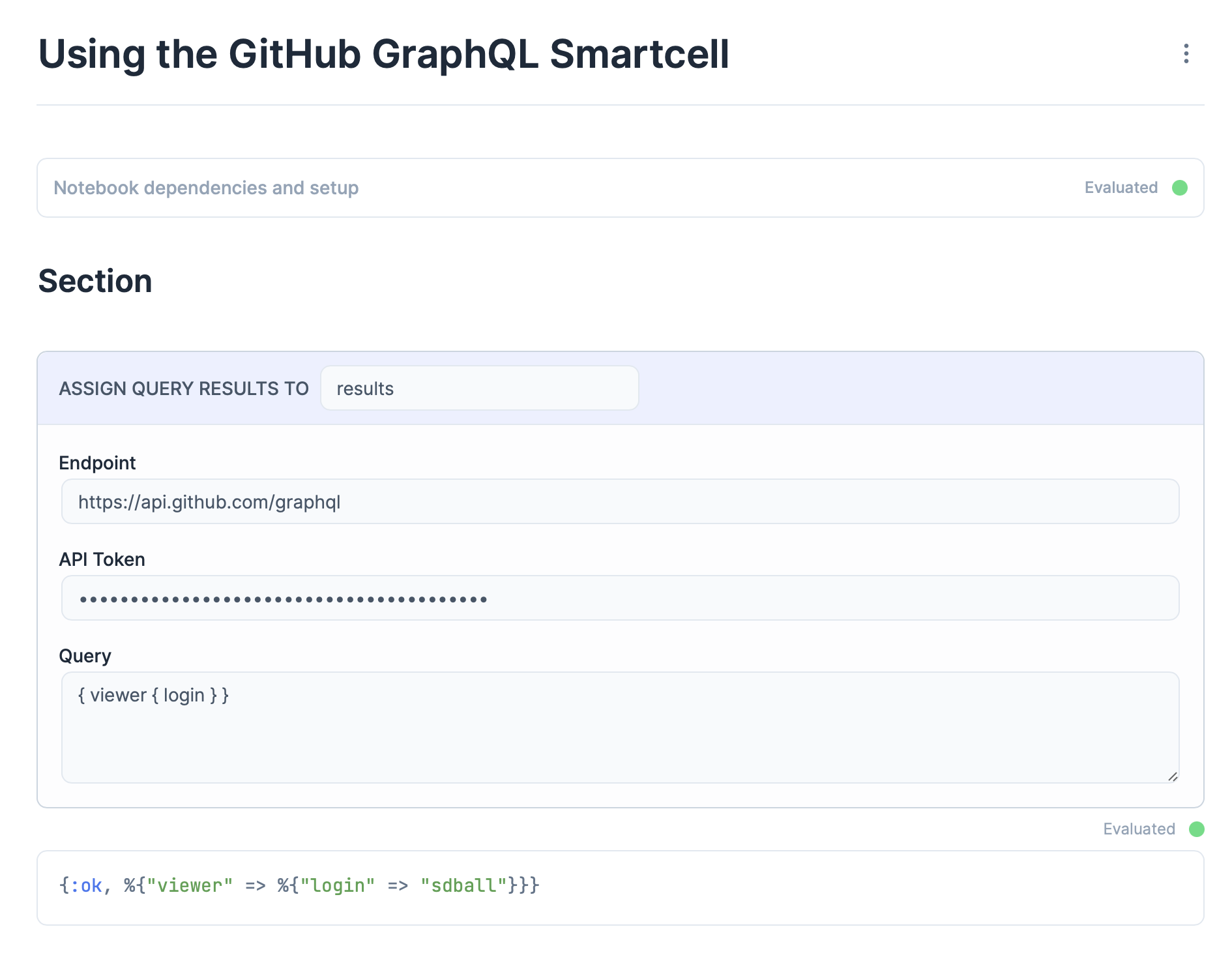
And the query results are correctly placed into the results variable (or whatever variable you named)

Because it’s a smart cell you can check out the generated code at any time.
{:ok, results} =
GitHub.GraphQL.query("{ viewer { login } }",
endpoint: "https://api.github.com/graphql",
token: "ghp_************************************"
)I hope this has helped demystify Livebook smart cells. To recap smart cells:
- Generate Elixir code in Livebook
- Have interconnected frontend and backend lifecycles
- Can save their data into the Livebook markdown